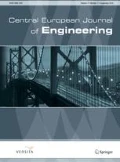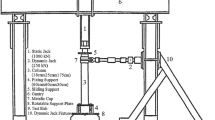Abstract
This study presents an application of peridynamic theory for predicting residual strength of impact damaged building components by considering a reinforced panel subjected to multiple load paths. The validity of the approach is established first by simulating a controlled experiment resulting in mixed-mode fracture of concrete. The agreement between the PD prediction and the experimentally observed behavior is remarkable especially considering the simple material model used for the concrete. Subsequently, the PD simulation concerns damage assessment and residual strength of a reinforced panel under compression after impact due to a rigid penetrator.
Similar content being viewed by others
References
Klein P.A., Foulk J.W., Chen E.P., Wimmer S.A., et al. Physics-based modeling of brittle fracture: Cohesive formulations and the application of meshfree methods, Theor. Appl. Fract. Mech., Vol. 37, 2001, 99–166
Moes N., Dolbow J., Belytschko T., A finite element method for crack growth without remeshing, Int. J. Numer. Meth. Eng., Vol. 46, 1999, 131–150
Zi G., Rabczuk T., Wall W., Extended Meshfree Methods without Branch Enrichment for Cohesive Cracks, Comput. Mech., Vol. 40, 2007, 367–382
Silling, S.A., Reformulation of Elasticity Theory for Discontinuities and Long-Range Forces, J. Mech. Phys. Solid, Vol. 48, 2000, 175–209
Silling S.A, Epton M., Weckner O., Xu J., et al., Peridynamics States and Constitutive Modeling, J. Elasticity, Vol. 88, 2007, 151–184
Kilic B., Peridynamic Theory for Progressive Failure Prediction in Homogeneous and Heterogeneous Materials, Ph.D. dissertation, Department of Aerospace and Mechanical Engineering, Univ. Arizona, Tucson, Arizona, 2008
Silling S.A., Dynamic Fracture Modeling with a Meshfree Peridynamic Code, Second MIT Conference on Computational Fluid and Solid Mechanics, edited K.J. Bathe, Elsevier, Amsterdam, 2003, 641–644
Silling S.A., Askari, E., Peridynamic Modeling of Impact Damage, PVP, Vol. 489, edited by F.J. Moody, American Society of Mechanical Engineers, 2004, 197–205
Silling S.A., Askari, E., A Meshfree Method Based on the Peridynamic Model of Solid Mechanics, Computers and Structures, Vol. 83, 2005, 1526–1535
Gerstle W., Sau N., Silling S., Peridynamic modeling of concrete structures, Nucl. Eng. Des., Vol. 237,Issues 12–13, July 2007, 1250–1258
Silling S.A., Bobaru F., Peridynamic Modeling of Membranes and Fibers, Int. J. Non. Lin. Mech., Vol. 40, 2005, 395–409
Askari E., Xu J., Silling S., Peridynamic Analysis of Damage and Failure in Composites, 44th AIAA/ASME/ASCE/AHS/ASC Aerospace Sciences Meeting and Exhibit, Reno, Nevada, 2006, AIAA 2006-88
Colavito K.W., Kilic B., Celik E., Madenci E., Effect of Void Content on Stiffness and Strength of Composites by a Peridynamic Analysis and Static Indentation Test, 48th AIAA/ASME/ASCE/AHS/ASC Structures, Structural Dynamics, and Materials Conference, Honolulu, Hawaii, 2007, Paper No. 2007-2251
Xu J., Askari A., Weckner O., Razi H., Silling S., Damage and Failure Analysis of Composite Laminates under Biaxial Loads, 48th AIAA/ASME/ASCE/AHS/ASC Structures, Structural Dynamics, and Materials Conference, Honolulu, Hawaii, 2007, AIAA 2007-2315
Warren T.L., Silling S.A., Askari A., Weckner O., et al., A Non-ordinary State-based Peridynamic Method to Model Solid Material Deformation and Fracture, Int. J. Solid Struct., Vol. 46, 2009, 1186–1195
Foster J.T., Silling S.A., Chen W.W., Viscoplasticity Using Peridynamics, Sandia Report, SAND2008-7835, 2008
Kilic B., Agwai A., Madenci E., Peridynamic Theory for Progressive Damage Prediction in Centre-Cracked Composite Laminates, Compos. Struct., Vol. 90,Issue 2, 2009, 141–151
Kilic B., Madenci E., Structural Stability and Failure Analysis Using Peridynamic Theory, Int. J. Non. Lin. Mech., Vol. 44,Issue 8, 2009, 845–854
Gálvez J.C., Elices M., Guinea G.V., Planas J., Mixed mode fracture of concrete under proportional and nonproportional loading, Int. J. Fract., 94: 267–284, 1998
EMU website, http://www.sandia.gov/emu/emu.htm
Ha Y.D., Bobaru F., Characteristics of dynamic brittle fracture captured with peridynamics, Eng. Fract. Mech., Vol. 78, 2011, 1156–1168
Demmie P.N., Silling S.A., An approach to modeling extreme loading of structures using peridynamics, J. Mech. Mater. Struct., Vol. 2, 2007, 1921–1945
Author information
Authors and Affiliations
About this article
Cite this article
Oterkus, E., Guven, I. & Madenci, E. Impact damage assessment by using peridynamic theory. cent.eur.j.eng 2, 523–531 (2012). https://doi.org/10.2478/s13531-012-0025-1
Received:
Accepted:
Published:
Issue Date:
DOI: https://doi.org/10.2478/s13531-012-0025-1




